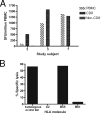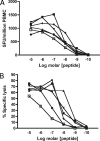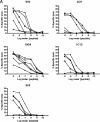Differential functional avidity of dengue virus-specific T-cell clones for variant peptides representing heterologous and previously encountered serotypes
- PMID: 17626101
- PMCID: PMC2045385
- DOI: 10.1128/JVI.00330-07
Differential functional avidity of dengue virus-specific T-cell clones for variant peptides representing heterologous and previously encountered serotypes
Abstract
Proinflammatory cytokines secreted by memory CD8+ and CD4+ T cells are thought to play a direct role in the pathogenesis of dengue virus infection by increasing vascular permeability and thereby inducing the pathophysiologic events associated with dengue hemorrhagic fever and dengue shock syndrome. Severe disease is frequently observed in the setting of secondary infection with heterologous dengue virus serotypes, suggesting a role for cross-reactive memory T cells in the immunopathogenesis of severe disease. We used a large panel of well-characterized dengue virus-specific CD8+ T-cell clones isolated from Pacific Islanders previously infected with dengue virus 1 to examine effector memory function, focusing on a novel dominant HLA-B*5502-restricted NS5(329-337) epitope, and assessed T-cell responses to stimulation with variant peptides representing heterologous serotypes. Variant peptides were differentially recognized by dengue virus 1-specific effector CD8+ cytotoxic T lymphocytes (CTL) in a heterogeneous and clone-specific manner, in which cytolytic function and cytokine secretion could be enhanced, diminished, or abrogated compared with cognate peptide stimulation. Dengue virus-specific CTL stimulated with cognate and variant peptides demonstrated a cytokine response hierarchy of gamma IFN (IFN-gamma) > tumor necrosis factor alpha (TNF-alpha) > interleukin-2 (IL-2), and a subset of clones also produced IL-4 and IL-6. Individual clones demonstrated greater avidity for variant peptides representing heterologous serotypes, including serotypes previously encountered by the subject, and IFN-gamma and TNF-alpha secretion was enhanced by stimulation with these heterologous peptides. Altered antiviral T-cell responses in response to stimulation with heterologous dengue virus serotypes have implications for control of virus replication and for disease pathogenesis.
Figures






Similar articles
-
Dengue virus-reactive CD8+ T cells display quantitative and qualitative differences in their response to variant epitopes of heterologous viral serotypes.J Immunol. 2006 Mar 1;176(5):2817-24. doi: 10.4049/jimmunol.176.5.2817. J Immunol. 2006. PMID: 16493038
-
Cross-Reactivity and Anti-viral Function of Dengue Capsid and NS3-Specific Memory T Cells Toward Zika Virus.Front Immunol. 2018 Oct 1;9:2225. doi: 10.3389/fimmu.2018.02225. eCollection 2018. Front Immunol. 2018. PMID: 30327651 Free PMC article.
-
Altered cytokine responses of dengue-specific CD4+ T cells to heterologous serotypes.J Immunol. 2005 Aug 15;175(4):2676-83. doi: 10.4049/jimmunol.175.4.2676. J Immunol. 2005. PMID: 16081844
-
Understanding the contribution of cellular immunity to dengue disease pathogenesis.Immunol Rev. 2008 Oct;225:300-13. doi: 10.1111/j.1600-065X.2008.00678.x. Immunol Rev. 2008. PMID: 18837790 Review.
-
Dengue fever virus and Japanese encephalitis virus synthetic peptides, with motifs to fit HLA class I haplotypes prevalent in human populations in endemic regions, can be used for application to skin Langerhans cells to prime antiviral CD8+ cytotoxic T cells (CTLs)--a novel approach to the protection of humans.Virus Genes. 1994 Sep;9(1):33-45. doi: 10.1007/BF01703433. Virus Genes. 1994. PMID: 7871759 Review.
Cited by
-
HLA Class I Supertype Associations With Clinical Outcome of Secondary Dengue Virus Infections in Ethnic Thais.J Infect Dis. 2015 Sep 15;212(6):939-47. doi: 10.1093/infdis/jiv127. Epub 2015 Mar 4. J Infect Dis. 2015. PMID: 25740956 Free PMC article.
-
Human T Cell Response to Dengue Virus Infection.Front Immunol. 2019 Sep 4;10:2125. doi: 10.3389/fimmu.2019.02125. eCollection 2019. Front Immunol. 2019. PMID: 31552052 Free PMC article. Review.
-
Meta-analysis of all immune epitope data in the Flavivirus genus: inventory of current immune epitope data status in the context of virus immunity and immunopathology.Viral Immunol. 2010 Jun;23(3):259-84. doi: 10.1089/vim.2010.0006. Viral Immunol. 2010. PMID: 20565291 Free PMC article.
-
Mouse Models of Heterologous Flavivirus Immunity: A Role for Cross-Reactive T Cells.Front Immunol. 2019 May 9;10:1045. doi: 10.3389/fimmu.2019.01045. eCollection 2019. Front Immunol. 2019. PMID: 31143185 Free PMC article. Review.
-
Protection from secondary dengue virus infection in a mouse model reveals the role of serotype cross-reactive B and T cells.J Immunol. 2012 Jan 1;188(1):404-16. doi: 10.4049/jimmunol.1102124. Epub 2011 Nov 30. J Immunol. 2012. PMID: 22131327 Free PMC article.
References
-
- Abe, Y., S. Sekiya, T. Yamasita, and F. Sendo. 1990. Vascular hyperpermeability induced by tumor necrosis factor and its augmentation by IL-1 and IFN-γ is inhibited by selective depletion of neutrophils with a monoclonal antibody. J. Immunol. 145:2902-2907. - PubMed
-
- Bashyam, H. S., S. Green, and A. L. Rothman. 2006. Dengue virus-reactive CD8+ T cells display quantitative and qualitative differences in their response to variant epitopes of heterologous virus serotypes. J. Immunol. 176:2817-2824. - PubMed
-
- Chen, H. D., A. E. Fraire, I. Joris, M. A. Brehm, R. M. Welsh, and L. K. Selin. 2001. Memory CD8+ T cells in heterologous antiviral immunity and immunopathology in the lung. Nat. Immunol. 2:1067-1076. - PubMed
-
- De Magistris, M. T., J. Alexander, M. Coggeshall, A. Altman, F. C. A. Gaeta, H. M. Grey, and A. Sette. 1992. Antigen analog-major histocompatibility complexes act as antagonists of the T cell receptor. Cell 68:625-634. - PubMed
Publication types
MeSH terms
Substances
Grants and funding
LinkOut - more resources
Full Text Sources
Other Literature Sources
Research Materials

